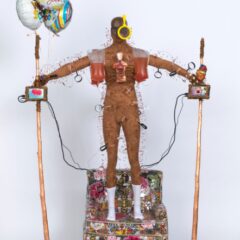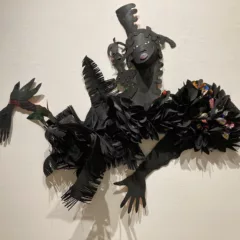
Catching up on my online reading I noticed Tyler Green at Modern Art Notes talking about SF MOMA‘s re-installation of its collection — done recently and done in the thematic way Tate Modern reinstalled its collection.
Read Green here. SF artist and blogger Anna Conti also wrote a comprehensive reflection on the museum here. (image is the museum’s stripe-happy lobby, the only place you’re allowed to take photographs)
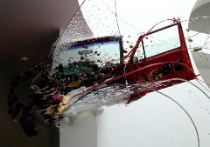
I didn’t dip into the collection much when we visited. Mostly I was on a hunt for the new William Kentridge and Pipilotti Rist pieces which Conti had clued me in about.
And I was hoping to see again a piece I’d seen in my last visit, Sarah Sze‘s “Things Fall Apart,” an installation made from parts of an SUV that threaded itself in and out of the balcony walls overlooking the atrium. Like all Sze installations, this benevolent infestation made use of an army of tiny, breakable materials like toothpicks and packing peanuts that seemed to adorn the auto parts and imbue them with spooky, spacey energy. (image is detail)
I loved the fragile ecosystem within the cut open industrial behemoth but sadly it was gone. The piece, commissioned by the museum, was in storage, according to a helpful admissions desk person.
Read more here and see more pictures here.
Tide Table
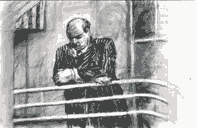
Upstairs on two, we wound our way through the museum’s current design exhibit and into the permanent collection where we found the Kentridge piece, “Tide Table” (2003) (image is detail) enthroned in a gallery with works by two artists that made a perfect complement — Phillip Guston and the late great California ceramic sculptor Robert Arneson.
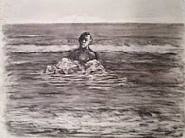
Kentridge’s piece is a new acquisition that includes an animation and six drawings from which it was made. The piece, like other Kentridge works, intertwines the character Soho Eckstein, a white industrialist who is the stand-in for the artist, with the lives of black South Africans.
Here, Soho vacations at the beach and quickly the beach scene dissolves into one of hospital-dormitories with people dying of AIDS. The tide comes in, the tide goes out like the lives ebbing and flowing in this alternate universe that swims underneath the seemingly oblivious Soho. (image is another detail)
The piece’s soundtrack is mournful, intersplicing quiet waves with sad songs sung acapella.

The piece had an affect of resignation I don’t remember from other works which seemed to have more anger and hope woven into their fabric. This work is like a Shroud of Turin — an artifact of something inevitable.
Kentridge’s drawings, which are surprisingly large, are themselves beautiful artifacts of the artist’s working method which includes building up and erasing down image after image to create the animation. (image is Kentridge working)
But the drawings stand on their own, too, and, fit in beautifully with the full-bodied works of Arneson and Guston.
Stir Heart, Rinse Heart
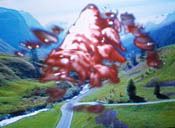
Pipilotti Rist’s new commissioned work is a video installation with themes of body played out against scenes of fussy interiors and mountain scenery. There’s an eating thing going on with rist devouring an orange then taking you on a kind of fantastic voyage inside her mouth and other interior parts. (image is detail)
A hypno-music video ambiance pervades, and my favorite part was not the part trippy, part gross interiors but the scene with the artist in bright yellow dress with bright red (menstrual?) blood spot on the rear meets some young men who bow down before her. She pats their heads and moves on. The blood goddess theme was kind of interesting, especially coming from a Swiss artist whose country is known for its Red Cross (first aid and blood donations) as well as its pristine, Alpine uptightness.
I remember Rist’s work at the Fabric Workshop in 1999, a sexy underwater romp. This work was harder to sit through but was in some ways more evocative.
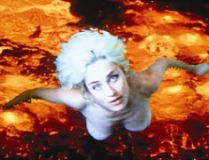
The anteroom you enter before seeing the new work includes another Rist piece, this one a kind of stealth presence. It’s a video installed in the floorboards. Tiny, no more than 2 inches square, the work, “Selfless in the Bath of Lava” (image) shows Rist as a nude blonde harpie sitting above the fires of hell haranguing the viewer in several languages. I loved this work for its Fellini-esque heroine and its surreality.
Pippi’s got the goods.



